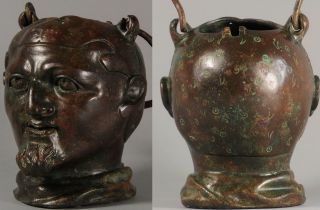The skeleton of an aged sports fan was found out alongside a 1,800-year-old jar molded like the head of a wrestler or boxer who may have possessed his nose broken, archaeologists documented.
The “spectacular” balsamarium which is a jar used to stock liquids such as balm or perfumes which was established in a grave in southeastern Bulgaria (ancient Thrace).
It goes back to a time when the Roman Empire regulated Thrace which is a historical area that comprised parts of Bulgaria, Greece, and Turkey.
Formed of brass, the balsamarium portrays a man with a goatee and a nose that seems crooked or bent as if it had been broken and not completely healed. The man is possessing a cap made from the skin of a feline, apt to be a panther or leopard, the archaeologists composed in a paper published in the October topic of the American Journal of Archaeology.
Instances of balsamariums that have identical features, such as aa twisted or bent nose, have been found somewhere else in the Roman Empire and are often comprehended as depicting boxers or wrestlers.
The feline cap possessed by the man may be an issue to a Nemean lion, aa beast that the Greek god Hercules fought and overthrew, as per the ancient mythology.
The archaeologists wrote in their paper that it is apparent that the manifestation of the athlete’s cap as the skin of a savage feline was implied to suggest the athlete’s resemblance to Hercules and, in this way, to imply the heroic power and courage maintained by the athlete.
The skeleton was also discovered in the grave related to a man who perished when he was about 35 to 40 years of age. Also laid to rest with the remains, the team discovered a blade used to scrape sweat and dirt from the surface.
The “spectacular” balsamarium which is a jar used to stock liquids such as balm or perfumes which was established in a grave in southeastern Bulgaria (ancient Thrace).
It goes back to a time when the Roman Empire regulated Thrace which is a historical area that comprised parts of Bulgaria, Greece, and Turkey.
Formed of brass, the balsamarium portrays a man with a goatee and a nose that seems crooked or bent as if it had been broken and not completely healed. The man is possessing a cap made from the skin of a feline, apt to be a panther or leopard, the archaeologists composed in a paper published in the October topic of the American Journal of Archaeology.
Instances of balsamariums that have identical features, such as aa twisted or bent nose, have been found somewhere else in the Roman Empire and are often comprehended as depicting boxers or wrestlers.
The feline cap possessed by the man may be an issue to a Nemean lion, aa beast that the Greek god Hercules fought and overthrew, as per the ancient mythology.
The archaeologists wrote in their paper that it is apparent that the manifestation of the athlete’s cap as the skin of a savage feline was implied to suggest the athlete’s resemblance to Hercules and, in this way, to imply the heroic power and courage maintained by the athlete.
The skeleton was also discovered in the grave related to a man who perished when he was about 35 to 40 years of age. Also laid to rest with the remains, the team discovered a blade used to scrape sweat and dirt from the surface.


No comments:
Post a Comment